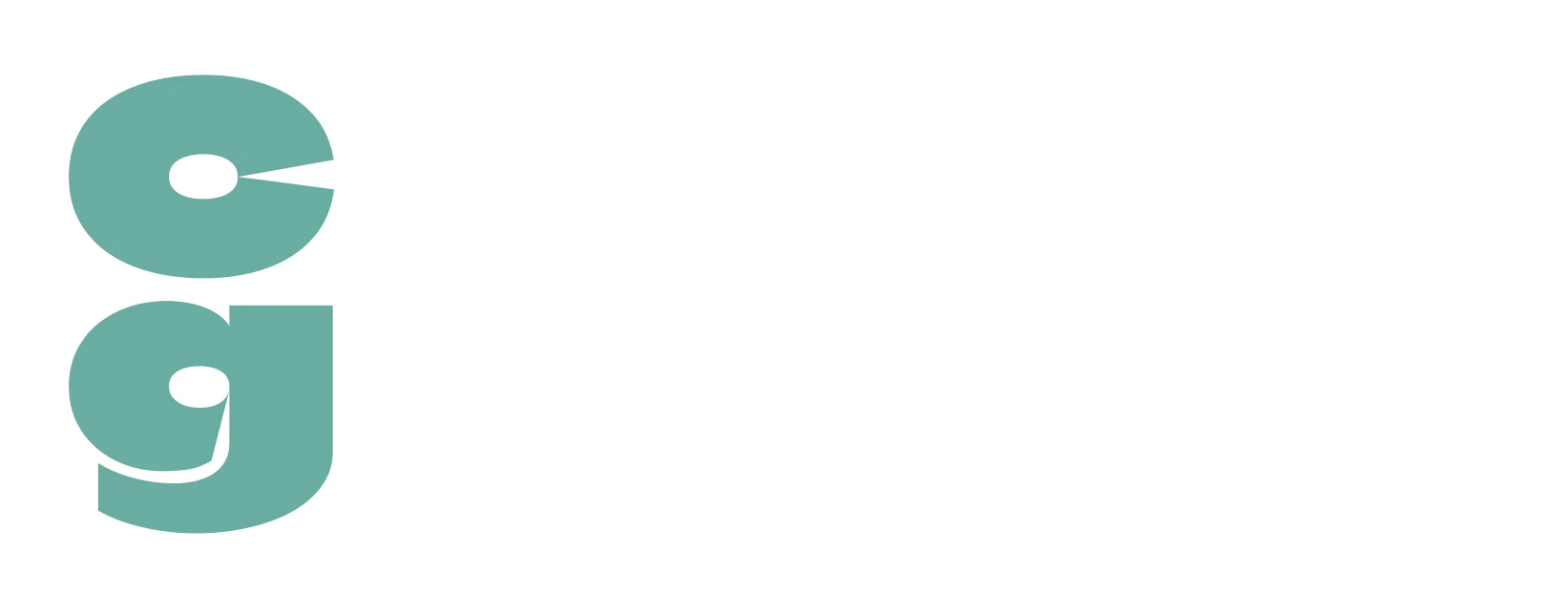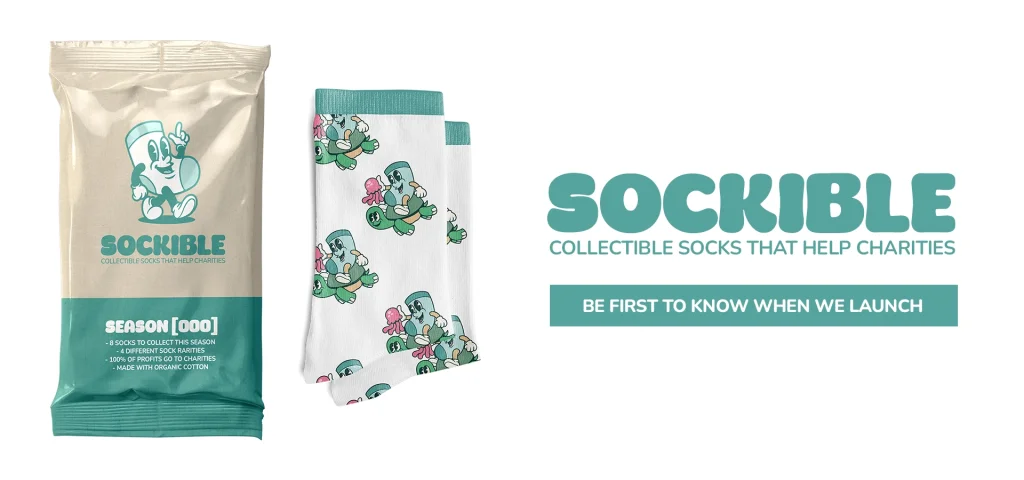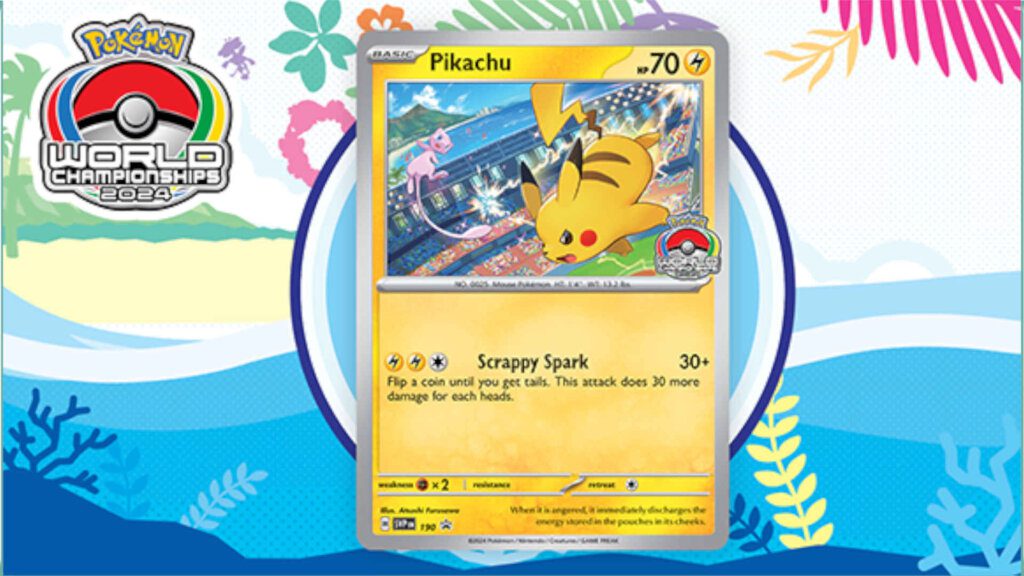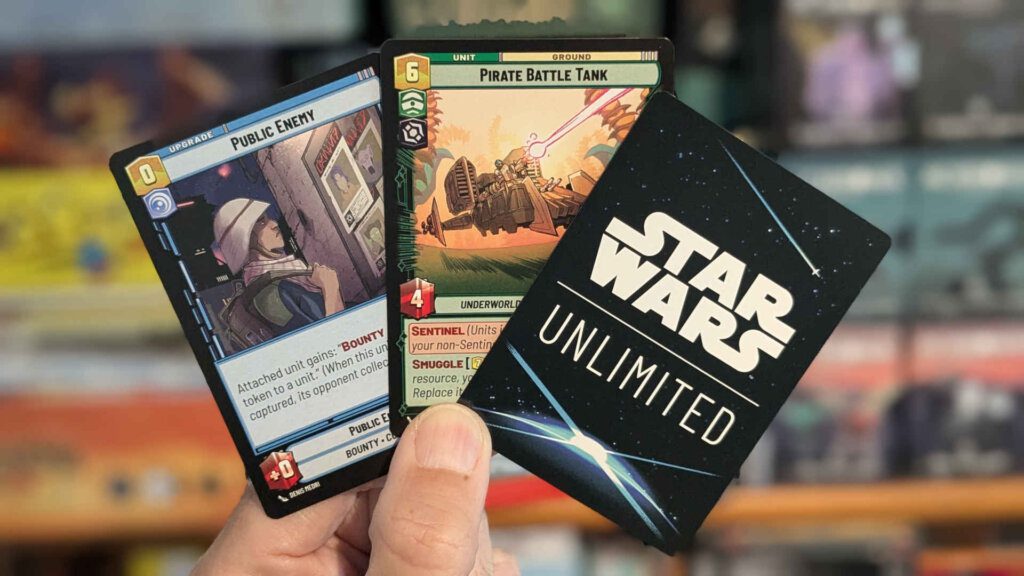Pokemon has been around in one form or another since the mid-90s; originally emerging as a Game Boy game, late into the monochrome handheld’s lifespan, Pokemon became a near instant sensation, thanks to the built in, compulsive need to catch all of the original 151 pocket monsters.
Perhaps the biggest masterstroke on the part of developers, Game Freak, was the fact that it wasn’t possible to collect every single creature using just one cartridge.
Instead, players would choose one of the two types of Pokemon cartridge (Red and Blue versions were available, each with slight variations in which Pokemon were available to catch) and, in order to complete their collection, would need to trade with other players using the Game Boy Link Cable.
The game and its innovative, collecting, battling and trading mechanics spread like wildfire among kids of all ages, and a number of adults too.
It wasn’t long before Pokemon moved in other directions, with an anime series, toys and a trading card game among the countless tie ins that supported and expanded the video games.
The trading card game itself became a phenomenon that’s still going strong to this day; it’s still hugely popular with fans of all ages, which includes adults who grew up playing Pokemon, or have maybe even been drawn into the game thanks to its clever mechanics and gorgeous card art.
If you have limited experience of Pokemon as a parent, however, or if perhaps you haven’t played or collected the cards since you were a child yourself, it isn’t all that straightforward to know where to start or how to help your child (or children) with learning to play the game.
There’s a bewildering number of product types, and very few are targeted towards absolute beginners or have any useful information included with them on how to get going with the game.
One of the joys of being a parent is being able to bond with your children and share the excitement they have for their interests and hobbies, but it’s difficult to do so when you don’t even know where to begin, what everything means or even how to play a game with them.
So here at Card Gamer, we’ve put together a handy guide for you; let’s go over all the information you need to know in order to get started with playing and collecting Pokemon.
Table of Contents
ToggleA Guide To Playing The Pokemon TCG
As mentioned, there are so many different types of Pokemon Trading Card Game (or TCG) product, that it’s really hard to know where to begin.
If your child is only interested in collecting the cards, there’s nothing wrong with that.
Even many adult Pokemon fans (and there are plenty of them!) are sometimes interested in just collecting the cards, rather than actually playing the game.
If, however, your child wants to actually play the TCG, there’s a couple of excellent starting points we can highly recommend, depending on your child’s age and/or experience with card games in general.
1. Pokemon TCG: My First Battle
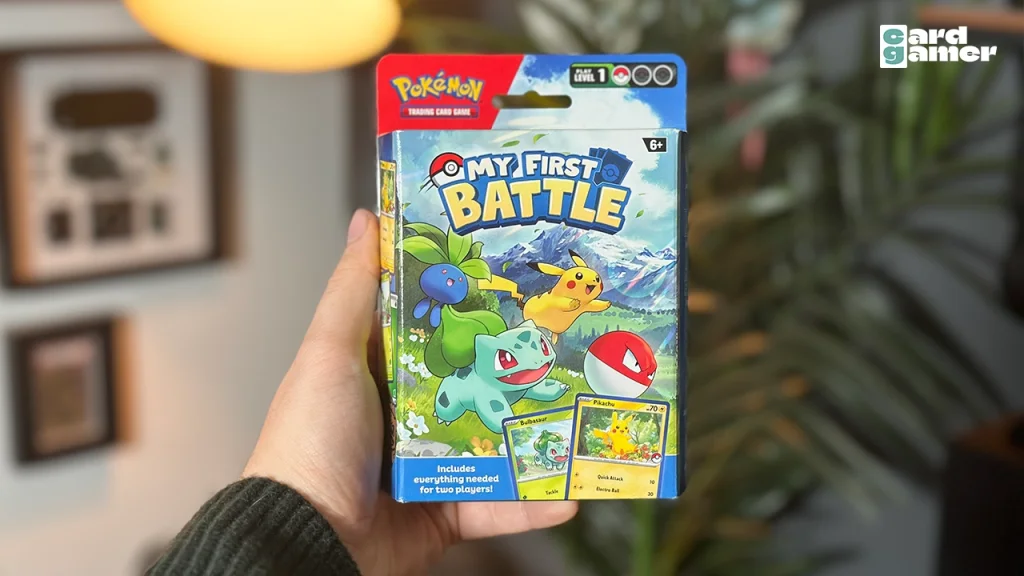
First up, if you have a particularly young child who wants to play Pokemon, but may not quite have the patience or experience needed to play the ‘full’ game, the absolute best product to buy for them is a My First Battle set.
There are two variations, with one set featuring Bulbasaur and Pikachu, and the other featuring Charmander and Squirtle.
It doesn’t really matter which of these two sets you choose; just go for whichever characters your child likes more!
In each My First Battle set, you get two decks of cards, play mats, tokens and a Pokemon coin.
The decks have a reduced number of cards, streamlined rules and helpful reminders on each game mat as to what players can do on their turn.
It’s definitely worth noting, however, that the cards included in these sets are not compatible with any other Pokemon sets or packs; they have a different card back to the standard Pokemon card design, so they can only be used as a tool to learn and play a very basic version of the Pokemon TCG.
Which is why we’d more strongly direct you towards the Pokemon Battle Academy set.
2. Pokemon Battle Academy
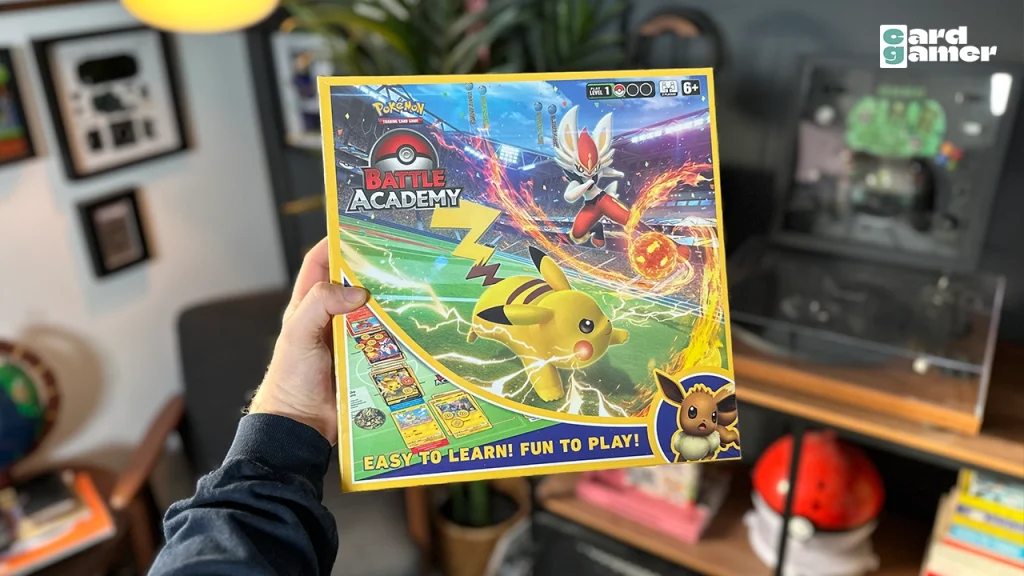

Packaged in a nicely sized, square box, the Pokemon Battle Academy looks more like a standard, self contained board game than a Trading Card Game; however, the cards included are fully compatible with any other Pokemon cards (My First Battle aside, of course) and it does teach players a full version of the game.
Included in the Pokemon Battle Academy box are three complete, full size decks, a board (instead of play mats) and all of the tokens and accessories you need to immediately get playing.
The included guides assist players with their first game in an intuitive and easy to grasp manner, with the decks themselves being simple to use too.
To begin, players will take either the Pikachu or Cinderace deck, then battle each other. Once they’re more confident with how the game works, the included Eevee deck is a slightly more advanced deck to help them learn new concepts and tactics.
What’s great is that the included cards are, as mentioned, standard Pokemon cards; this means that not only can the decks be ‘broken down’ (and easily put back together, as lists of the cards in each of the three decks are included) and used with any other Pokemon cards you acquire, you can experiment with building your own deck using a complete mixture of the three sets of cards here!
A Guide To Playing The Pokemon TCG (For Casual Players)
If you or your child already have a basic grasp of how Pokemon TCG plays (perhaps if you’ve played the game yourself, for example), then we’d highly recommend a battle deck.
1. Pokemon Battle Decks
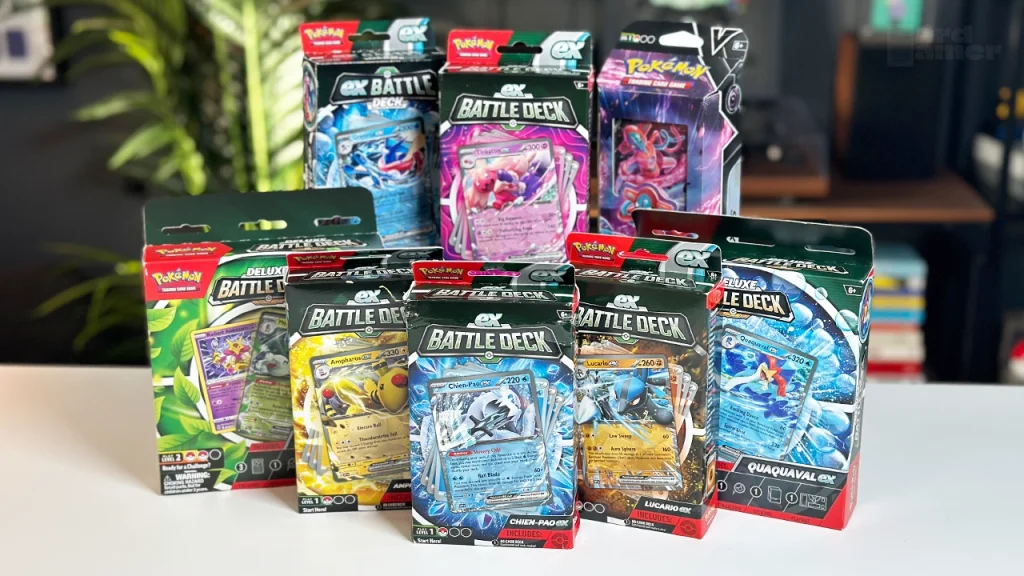

Note that there are different levels of complexity when it comes to battle decks and they generally only cater for a single player, so if you want your own deck as well as having one for your child, you’ll need to buy two.
The complexity level is marked on the front of the box, towards the bottom, with a Level indicator; this can be Level 1, 2 or 3 and, as you’d expect, you’ll want to start with a Level 1 battle deck.
These decks come with everything you need to play, including a full 60 card deck, rules, a play mat, reference cards, tokens, a cardboard deck box and even a strategy guide to help you understand how your chosen deck is intended to work in-game.
Like the Battle Academy set, any cards you get in a Battle Deck will be entirely compatible with any other Pokemon cards you buy.
That means that you can find a favourite Battle Deck, perhaps based around a specific character or even Energy type, and use it as the basis for building and customising your own, personal deck.
There really are a bewildering number of Pokemon TCG products that’ll greet you any time you check out a Pokemon display in store or online.


It’s very easy to look at some types of product and think they’ll give you everything you need to get started, but that’s not the case with everything you see.
For example, Elite Trainer Boxes look like a comprehensive type of product that’ll give you a good selection of cards and accessories; however, you’ll only really want to pick one of these up once you’ve got a functioning deck already, as it would not provide you with enough cards to build a functioning, playable 60 card deck in itself (unless you happened to be incredibly lucky with the booster packs it contains!).
Basically, any pack which contains booster packs and a few specific Pokemon cards, such as Premium Collections featuring specific characters, are intended for use either by collectors or players who just need to bolster, or improve, the selection of cards they have available to customise their deck with.
It likely goes without saying, but individual booster packs are also intended only to widen the selection of cards you have in your collection and can’t, on their own, simply be opened and played with.
Learning To Play The Pokemon TCG
Now that you know what products are best to buy, let’s take a look at how you play the Pokemon Trading Card Game.
1. The Rules of Pokemon TCG
You can check out the handy Card Gamer guide on how to play Pokemon for a more in depth guide, or check out the video below:
It’s worth noting that the Pokemon TCG rules are straightforward enough to summarise the main points.
To start, a player is chosen to declare heads or tails, then a coin is flipped. The winner of the coin flip gets to choose who goes first.
Each player draws a hand of seven cards from their deck; if they have no Basic Pokemon in their hand, they can redraw, but for each time they redraw, their opponent can draw an extra card to their opening hand.
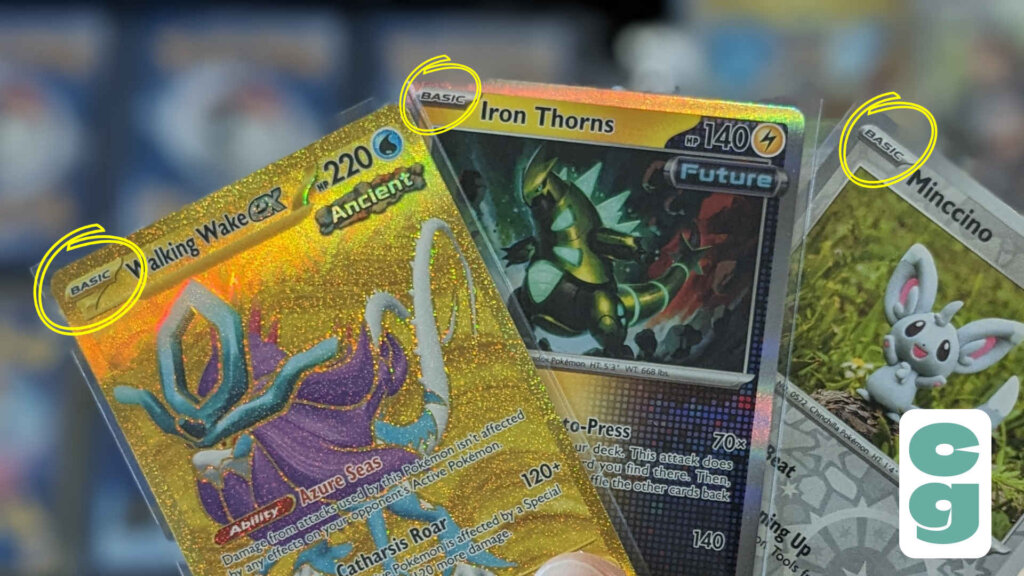

In the image above, you can see that any card art type or rarity can be a Basic Pokemon; what you’re looking out for is the word ‘Basic’ in the top left of the card.
Six cards are then drawn and placed face down as Prize Cards to the side of the main play area (which we’ve shown and marked for you below); these are drawn when you Knock Out an opponent’s Pokemon, and when you have no Prize Cards left, you win!
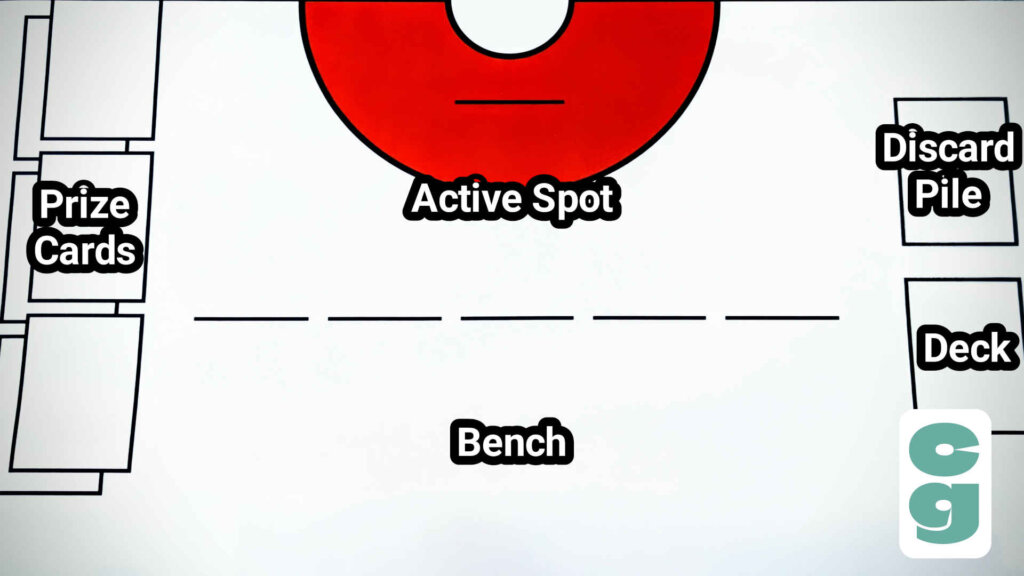

To begin, players place Basic Pokemon in their play area face down; one in their Active Spot and up to five on their Bench.
So when you set up your game, your play area should look like the image below. Once both players have finished setting up, they turn over their Active and Benched Pokemon simultaneously, then the game is ready to begin!
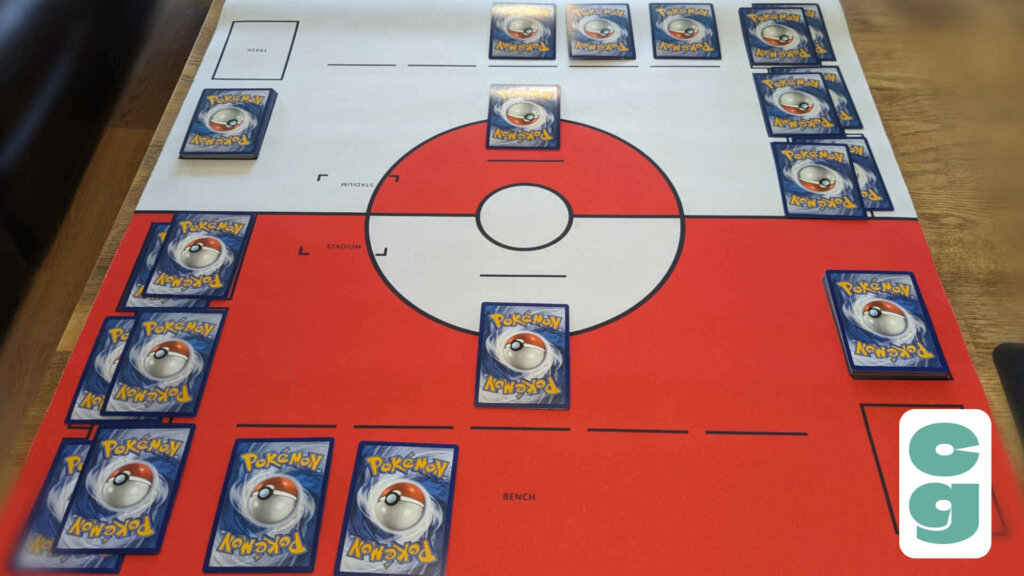

Each turn, starting with the Active Player, players will draw a card from their deck and then perform the following actions; as many times as they are able, in any order (unless specified otherwise):
- Evolve a Pokemon by placing a Stage 1 or Stage 2, or other type of Pokemon, on a Pokemon that’s already in play. You can do this as long as the Pokemon you’re using to evolve has the specific Pokemon in play named on its card (see the below image of Glimmet and Glimmora ex); also note that the Pokemon in play cannot be evolved on the turn it was played.
- Play a Basic Pokemon from their hand to their Bench (up to five Pokemon can be on the Bench)
- Attach an Energy card to one of your Pokemon (only once per turn).
- Play a Trainer card (note that Supporter cards can only be played once per turn).
- Use a Pokemon’s ability (these will usually be once per turn, per Pokemon, but will be specified on the card).
- Retreat a Pokemon from your Active Spot to your Bench (paying the Pokemon’s specified Energy cost to do so; these are discarded from the Pokemon’s attached Energy cards).
- Use one of the Active Pokemon’s attacks on the opposing Active Pokemon (this ends the current player’s turn).
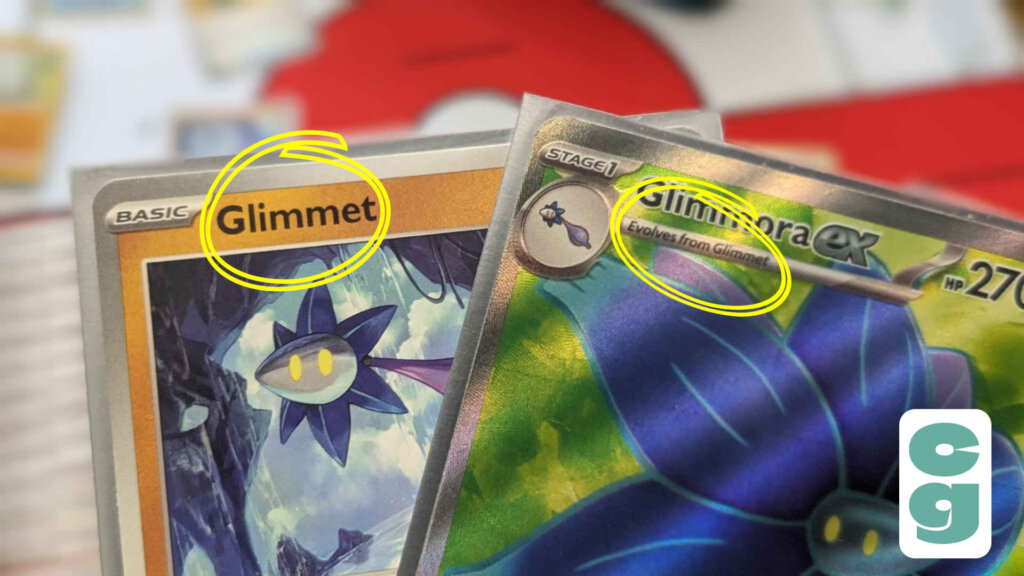

Attacking is a case of making sure you have the right cards attached to your Active Pokemon to use the specific attack; this then deals specified HP damage to the opposing Pokemon (marked using damage counters), also taking into account weakness (which doubles damage if the opposing Pokemon is weak to your Pokemon’s type) or resistance (which reduces damage by 30 if it matches your Pokemon’s energy type).
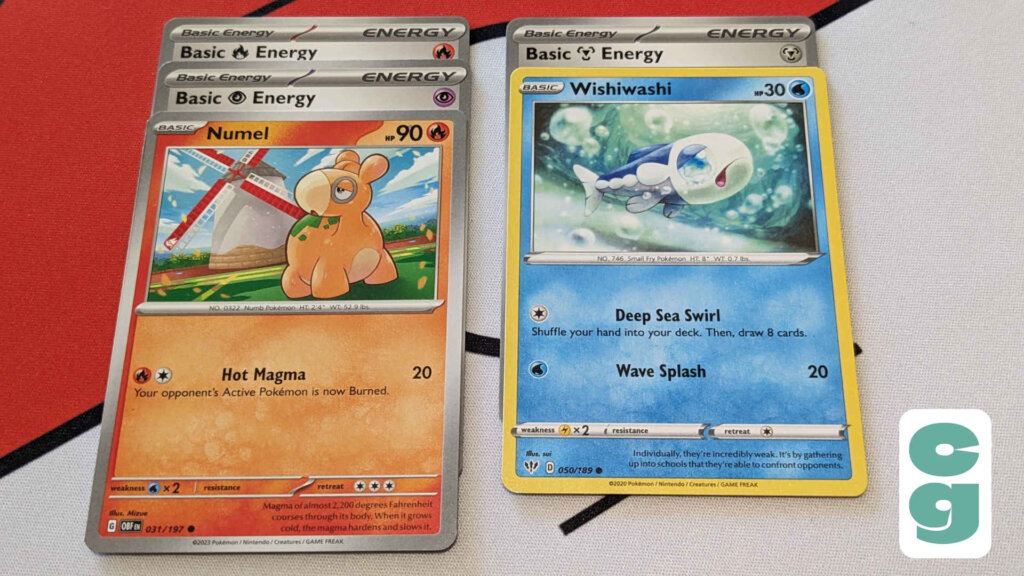

In the example above, the Numel can attack the Wishiwashi with Hot Magma, as it has two Energy cards attached: one Fire Energy and one Psychic Energy card, as shown by their symbols and card text.
Hot Magma needs one Fire Energy card and one of any type of Energy card (the symbol shown next to the Fire Energy is known as Colorless, so any Energy card will work) in order to be used.
Hot Magma will deal 20 points of HP damage to the Wishiwashi, which has 30 HP. Damage counters totalling 20 HP will be added to the Wishiwashi.
It’s worth noting that, on the Wishiwashi player’s turn, it could not attack the Numel with Wave Splash as this requires one Water Energy card to be attached to the Pokemon; instead, it has a Metal Energy card attached.
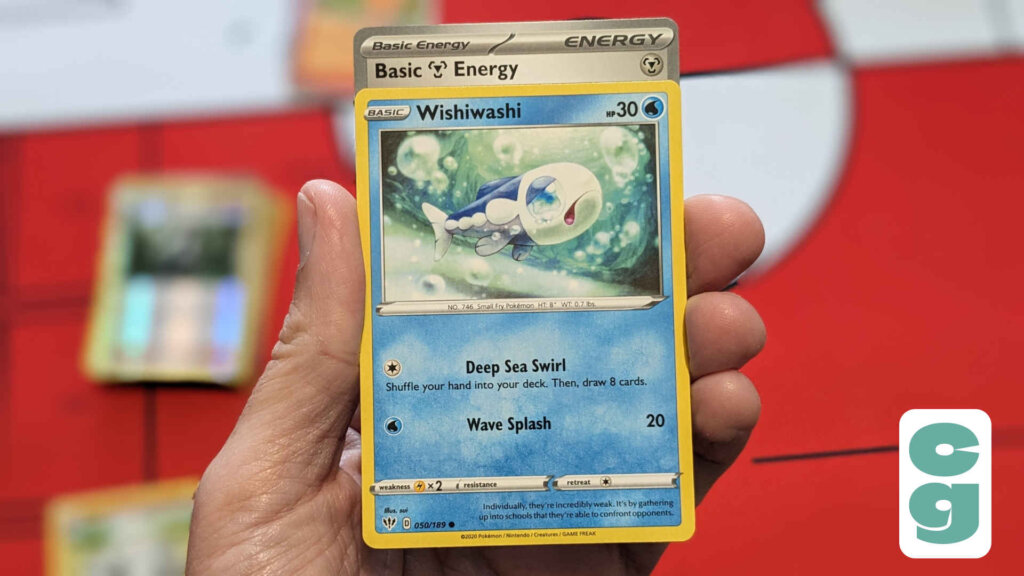

It could, however, use its Deep Sea Swirl, which requires one of any type of Energy (due to the Colorless Energy symbol being used for that one).
Other effects or conditions may apply (such as ‘Burned’, which the above Numel will inflict upon the Wishiwashi when it attacks), but you can learn these as you play.
If you reduce your opponent’s Pokemon’s HP to zero, it is Knocked Out, then discarded (along with all attached cards) and you draw a Prize Card, which you add to your hand.
If your opponent has another Pokemon or multiple Pokemon on their Bench, they choose one to be the Active Pokemon and play continues with their turn.
If you draw your last Prize Card, or your opponent has no cards to draw from their deck at the start of their turn, you win!
Those are the absolute basics of the Pokemon TCG; naturally, the different cards and card types can add further, more complex abilities and effects to the game, but this is where it becomes incredibly addictive, as you discover new combos and favourite effects to use in your own decks!
2. Building Pokemon Decks
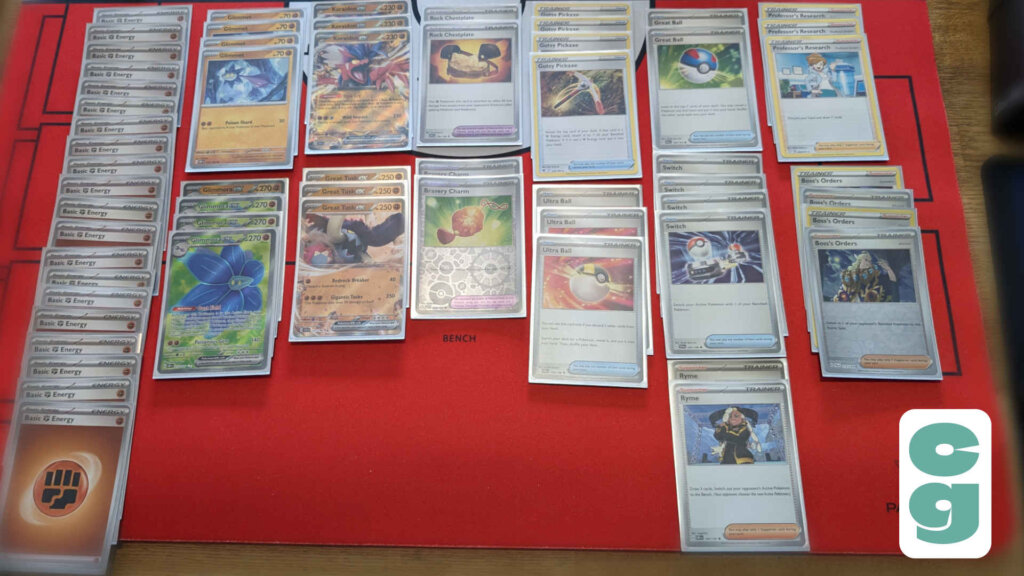

A big part of why Pokemon is such a popular game is the fact that players can build, or customise, their own decks. Above, you can see the exact deck that I’ve put together myself, adhering to the deck building rules of the Pokemon TCG, and which I use to play the game.
So let’s take a look at the deck building rules, along with some general tips for getting started.
To play Pokemon, players must have a 60 card deck; this can be composed of just about any Pokemon card you find in packs or sets, as long as it matches the standard Pokemon card back.
Do note that tournaments and other official events, unless marked as casual, will have a fairly firm stance on what cards can be used, with set codes on each card that will show whether or not they’re currently ‘legal’ for competitive play. If you do enter a local competition or play at a club, they’ll be able to let you know the current rules on what cards can and can’t be used.
For now though, just know that you’ll need at least 60 cards for your deck; this can be any number of Basic Energy cards, plus a mixture of Pokemon and Trainer cards to make up the rest of your deck.
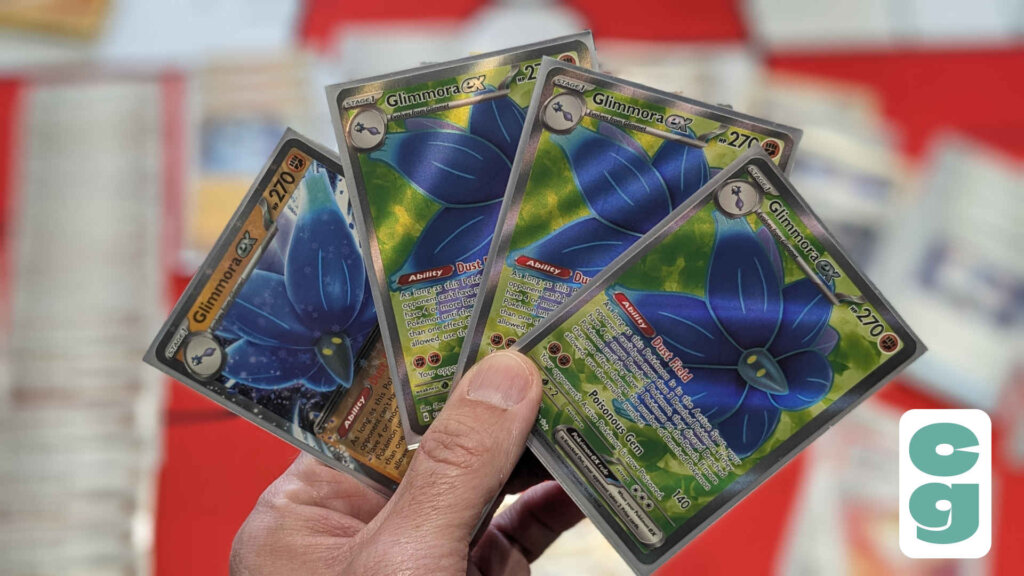

You can use up to four copies of any card with the exact same name as another in your deck; so, for example, you can have four copies of Glimmora ex, as seen above, regardless of what set it’s from, whether or not its attacks or abilities are the same, or whether its art is the same from card to card.
If it states Glimmora ex on the card as its name, as the above cards all do, then you can have a maximum of four of them in your deck.
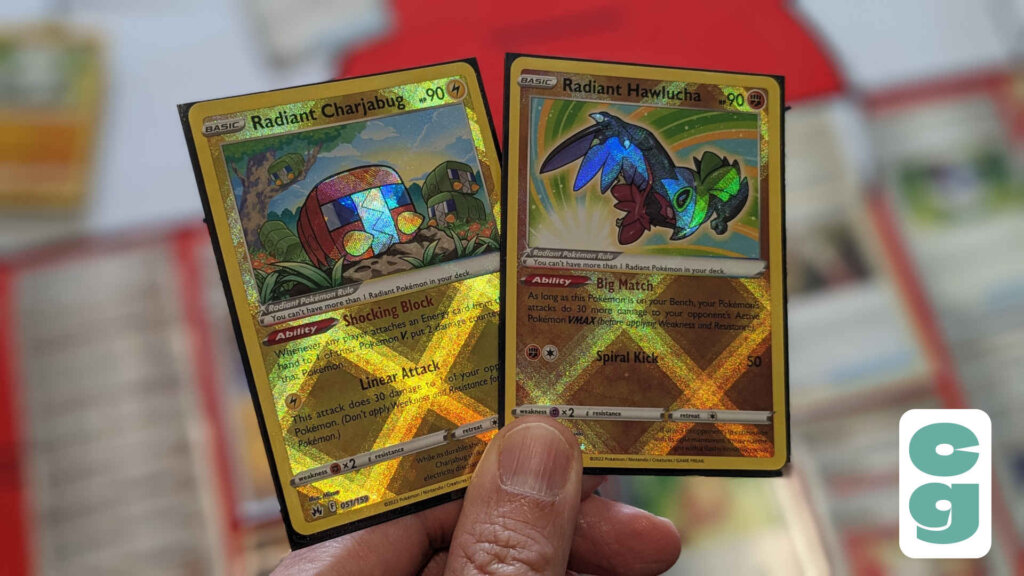

Note that there are exceptions; you can only have one Ace Spec card in your deck overall, for example, and this is also true for a Pokemon with Radiant in its name.
Whenever there are exceptions, these will be clearly marked on the card.
You’ll need to make sure that you have enough Energy cards in your deck to use your Pokemon’s attacks; for example, if you have Pokemon that use Fighting Energy, make sure you have Fighting Energy cards in your deck.
As a general rule, it’s much easier to use a deck that has Pokemon which use no more than two different Energy types, or you may find it difficult to draw the right Energy to use in the game.
Colorless Energy symbols can use any Energy card, so you’re free to add Pokemon which use Colorless Energy only, if you choose to!
When starting out, it might be easiest to stick to the rule of thirds; build your deck with 20 Pokemon, 20 Trainer cards and 20 Energy cards.
Make sure you have a good amount of Basic Pokemon so you can get them into play quickly, then have a smaller number of Pokemon at Stage 1 that evolve from the Basic Pokemon you have, and an even smaller selection of Stage 2 Pokemon.
Note that Pokemon V or Pokemon ex types are usually very powerful and quite often they count as Basic Pokemon too; keep an eye out for these! Note that they may award your opponent more than 1 Prize Card when they’re Knocked Out, however, so using them can be risky as well as rewarding!
Using 20 cards for each category of card type helps to simplify the process, and once you’ve played a few times you can see where you might need to tweak and fine tune your deck; for example, you’ll note where you may not have enough Energy for a certain type of Pokemon, or where you may need more Basic, or even stronger Pokemon.
Perhaps you need to control your opponent’s Pokemon a bit more, with cards such as Boss’s Orders.
You’ll find out what works and what doesn’t with your deck as you play, and it’s a great joy of the Pokemon TCG to build yourself a deck that works well against any opponent you may face!
4. How To Find Other Pokemon Players, Clubs And Events
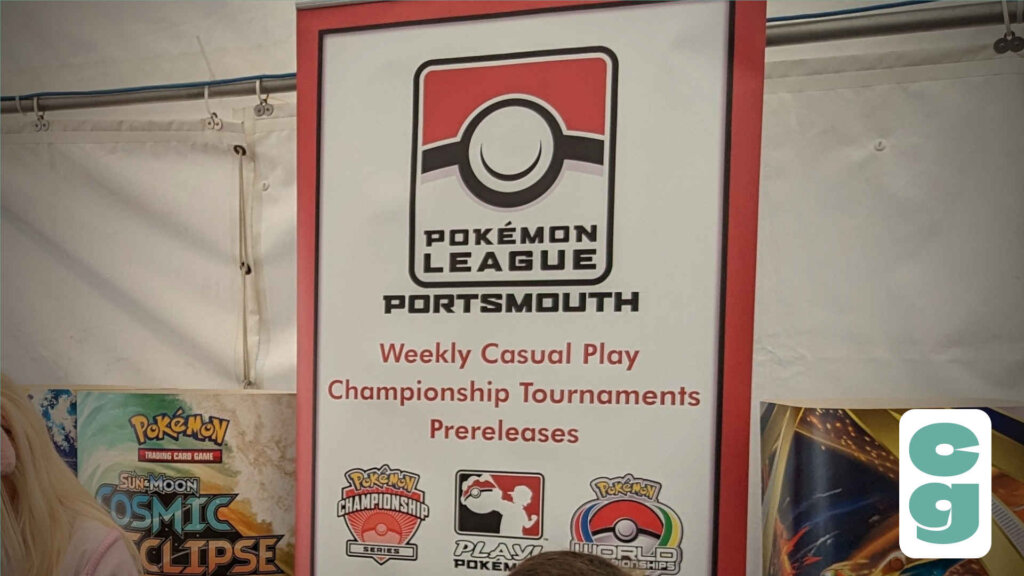

If you want to find more face to face assistance with the Pokemon TCG or you’re simply looking to play against more opponents, or in exciting events, the best way to find them is to use the official Pokemon TCG event locator.
You can search for the nearest stores and clubs in your area, and you’ll find that the staff, as well as other players, at these events are friendly, welcoming and always happy to assist new players with learning how to play Pokemon.
They tend to have decks and other accessories you can use to try the game too, so if you haven’t yet taken the plunge with the Pokemon TCG, it’s a great way to learn as you (and your child!) play.
How To Get Started With Collecting Pokemon Cards
Unlike playing Pokemon, there are no hard and fast rules to collecting, and no doubt your child will have their own preference (and budget, thanks to the amount of pocket money you give them!) that’ll determine the best options for them.
There’s also things we need to make sure you look out for!
1. What Products To Buy When You’re Getting Started With Collecting Pokemon Cards
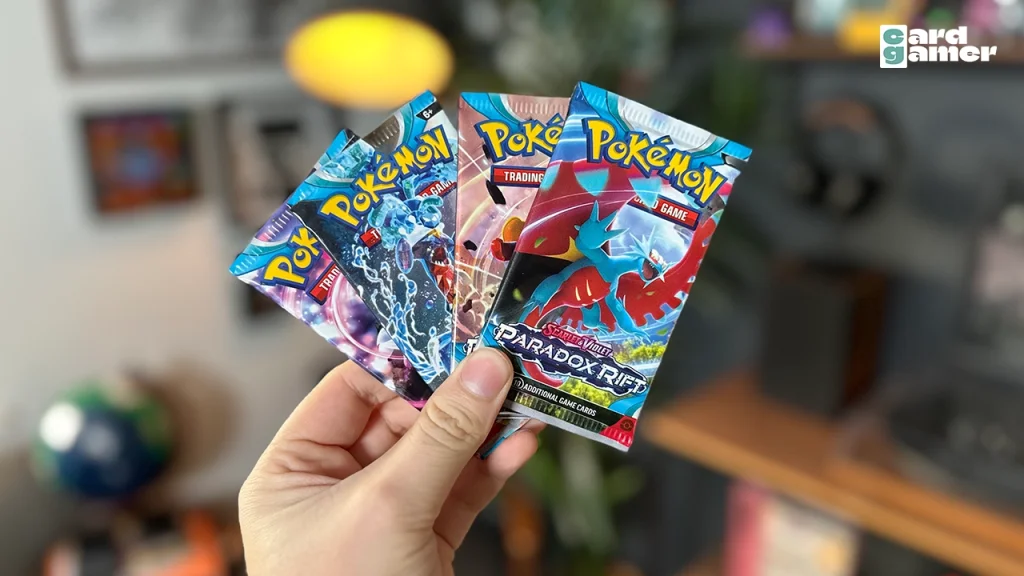

Pokemon booster packs are usually the first port of call for any child.
Note that each pack will contain a selection of Common, Uncommon and Rare (or higher) cards. There tends to be mostly Common, less Uncommon and, usually, just one Rare card with up to three foil-treated cards in a modern booster pack.
You can check out our guide to Pokemon card rarities here; you’ll see from there that some special card types may be found in any booster packs, though many are quite hard to come by.
We’d suggest that any set or box featuring a number of boosters will be perfect for collecting cards; Elite Trainer Boxes, for example, not only provide numerous boosters, but also exclusive Promo cards, special accessories and even the box itself is perfect for storing your burgeoning collection of cards!
2. How To Store And Take Care Of Your Card Collection


Trading Card Binders are the best way to store a card collection safely and ensure that they can still be viewed, or taken to events where other players will be willing to trade with your child.
Do note that we’d also advise using card sleeves to protect the rarer cards in your collection too; generally, we’d say that you should sleeve any foil card, or any card you’re going to use in a deck, but you may want to save your sleeves for only the rarest card types.
That’s because many rare (or higher) cards can hold significant value, and may even rise in value as the years pass.
We’ve heard far too many stories here at Card Gamer of people losing, disposing of or damaging cards that can sometimes be sold for much higher values than they were purchased for, so we’d highly recommend keeping an eye on the cards your child has and making sure that the most valuable (or the ones that have the most potential value, usually determined by their rarity) are taken care of!
Sites such as Cardmarket and TCG Player can be used to check the value of cards, with live market values that will tell you just how much your cards are worth!
3. What To Look Out For When Buying Pokemon Cards
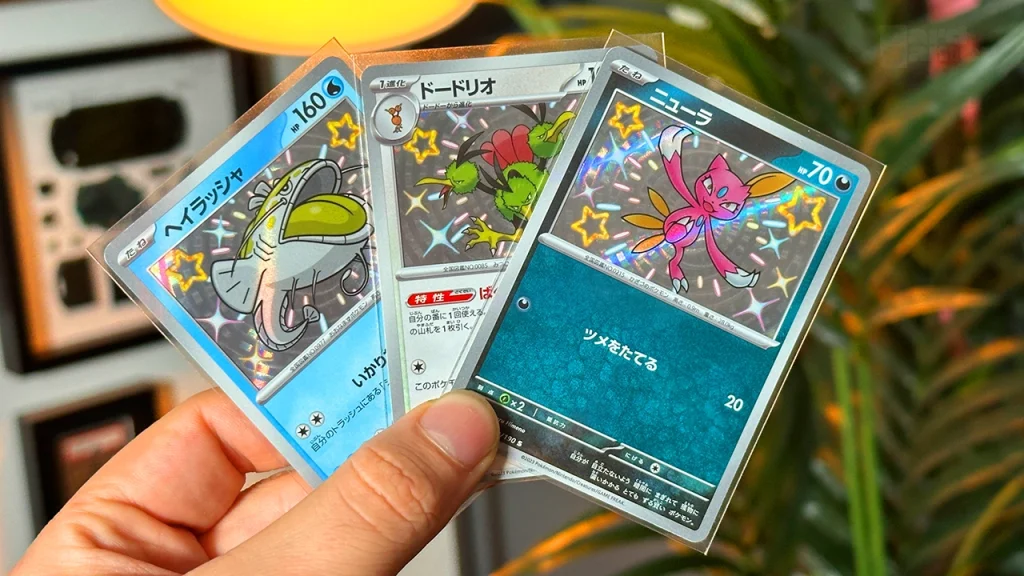

It can be very tempting to buy cheap bundles of cards online, from websites such as Amazon, eBay, or even AliExpress or Temu.
However, do be aware that many unscrupulous and deceptive sellers exist on all of those platforms; for Amazon and eBay, do make sure you check out the feedback and review scores of sellers before you buy any cards for your child; the general rule of thumb is that, though bargains do exist, if a bundle’s price seems too good to be true, that’s generally because the cards are fake.
We’d also advise to stay away from buying cards from Chinese-based sites such as AliExpress or Temu, as these will almost always be fake.
4. How Do I Tell If A Pokemon Card Is Fake?
Though your child and their friends may have no issue at all with having fake cards, which are more prevalent than you may imagine, they will often be unusable in games, even if they play casually with friends, due to typos, errors and poor print quality; they won’t hold any value for collecting either.
Though there are numerous ways to tell if cards are genuine or fake, the easiest is to just take a closer look at a card. Particularly with holographic or foil cards, they look and feel ‘premium’, with textured finishes and patterns that will be dull or cheap looking on a counterfeit card.
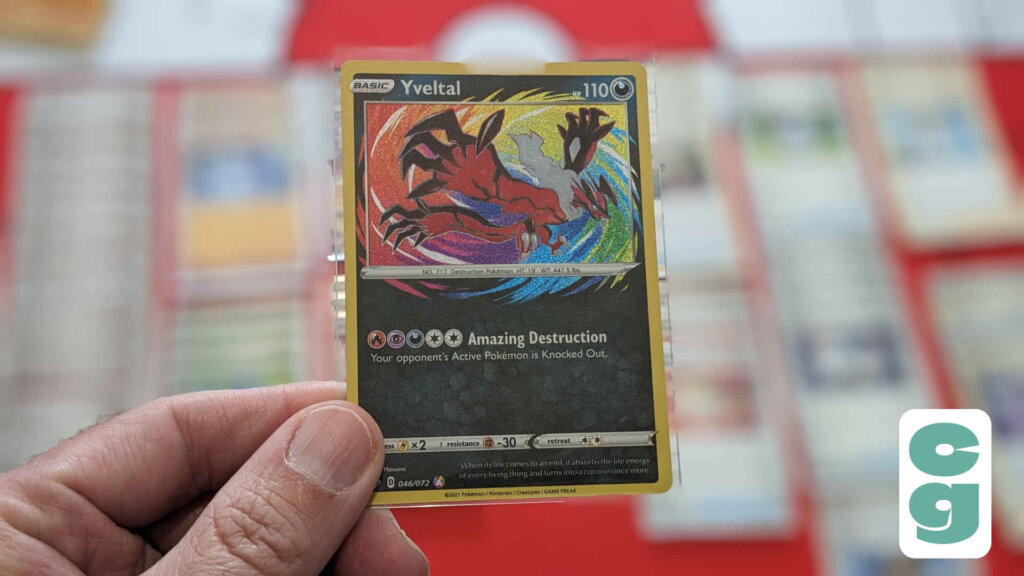

Sometimes, you’ll find higher HP or attack values than you may expect on a card; this, however, is difficult to spot if you don’t know what you’re looking for; the same is true of a Pokemon’s name, because how are you to know if a creature such as Yveltal is named correctly (just so you know, that is a real Pokemon, as you can see from the genuine card above) without prior knowledge of Pokemon?
Similarly, you may also find that the Pokemon illustration doesn’t match the name on the card, but again, without specific knowledge of Pokemon, you may not know if this is the case.
Here’s where your child will come in handy; most kids who already have an interest in Pokemon will have pretty encyclopaedic knowledge of what they’re called and what they look like, so they’ll be able to tell you if something’s up in that regard!
Another obvious clue to look out for is with the card’s construction; take a look at the side, top or bottom edges of a genuine Pokemon card, and you’ll note that it’s made of two thin pieces of white card, with a black line between them.
Fake cards are, of course, not made with any sort of high production values or quality in mind, so you won’t see that black line appear on counterfeits.
Reputable sites such as Total Cards, Magic Madhouse and Chaos Cards all sell single cards as well as bundles, and you can buy them with confidence that they’re genuine too!
So there you have it; that should be all of the information you need to help your child with playing, collecting, storing and even buying Pokemon cards; we hope this has helped to give you some assistance in knowing where to start in what can, at first, be a rather overwhelming hobby for a parent.
Not only that, but hopefully you now have a way to properly connect and engage with your child, with something that you can now be a lot more involved in!
This article may contain affiliate links. If you use these links to purchase an item we may earn a commission. Thank you for your support.
